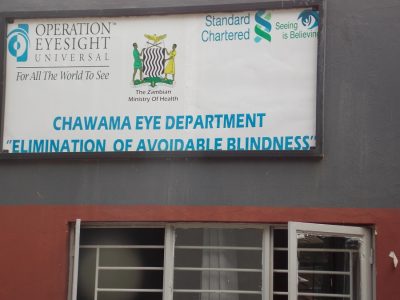Join a powerful, unprecedented alliance for better eye health for all.
Join IAPB-
Choose an alternate language here

Previously in Zambia, eye health programmes and general health programmes ran parallel to one another. Eye health was considered predominantly a donor-funded programme that did not rely on funding from the country’s central financial basket. Because of this parallel structure, most eye care programmes had to end once donor funding ended, and the burden of eye disease would recur.
Thanks to support from Seeing is Believing, Operation Eyesight implemented our “Elimination of Avoidable Blindness in Three Underserved Compounds of Lusaka” project. This project, the first of its kind in Zambia, aimed to ensure primary eye care services became an integral part of the primary health care system.
We engaged the Zambian Ministry of Health (MoH) in high-level discussions from the very beginning of the project. At the district level, we shared the project proposal, which the MoH accepted and adopted as their own eye service delivery idea, signing a Memorandum of Understanding.
First, we established eye care departments at primary health care facilities in the community compounds of Bauleni, Chawama and Mandevu in Lusaka. The buildings were renovated, and the eye departments were equipped with modern, primary eye care equipment.
The project required previously-trained ophthalmic personnel to be based at the eye departments. The District Health Office transferred these personnel from elsewhere in the district to the three new eye departments. This arrangement meant that we did not have to create new positions, as these personnel were already on the MoH or government payroll.
To ensure the surrounding communities accessed these new eye care services, we took a unique approach by training community health workers who had already been working at the primary health care facilities. They were trained to conduct door-to-door eye screenings, identify basic eye conditions and refer those with eye problems to the nearest eye department for treatment.
We implemented a referral system where patients from the community are screened and treated at the eye departments, and those in need of specialized services, such as cataract surgery, are referred to a tertiary hospital for further treatment. This has provided relief for the tertiary hospitals, since patients with basic eye care needs now seek treatment at the primary care level.
As with most new initiatives, this project did not proceed without its challenges. One issue was the limitation of basic eye care drugs, as the primary health facilities receive kits with only two types of drugs: tetracycline eye ointment and chloramphenicol eye drops. Another issue was the limited number of trained ophthalmic personnel in the district – and even those with ophthalmology training had forgotten most of their skills after recently working in more general areas. In addition, there are very few biomedical technicians available to service and repair the eye equipment that was provided to the eye departments.
Despite its challenges, this project was successful in integrating eye care into the primary health care system. The primary health care facilities now have basic primary eye care equipment and trained ophthalmic personnel, both of which will remain at the eye department after the close of the project. Even better, people in the surrounding communities will continue to seek eye care services because they have been educated by community health workers on the importance of eye health, and empowered to take ownership of their eye care needs.


By Patson Tembo
Country Manager – Zambia
Operation Eyesight Universal